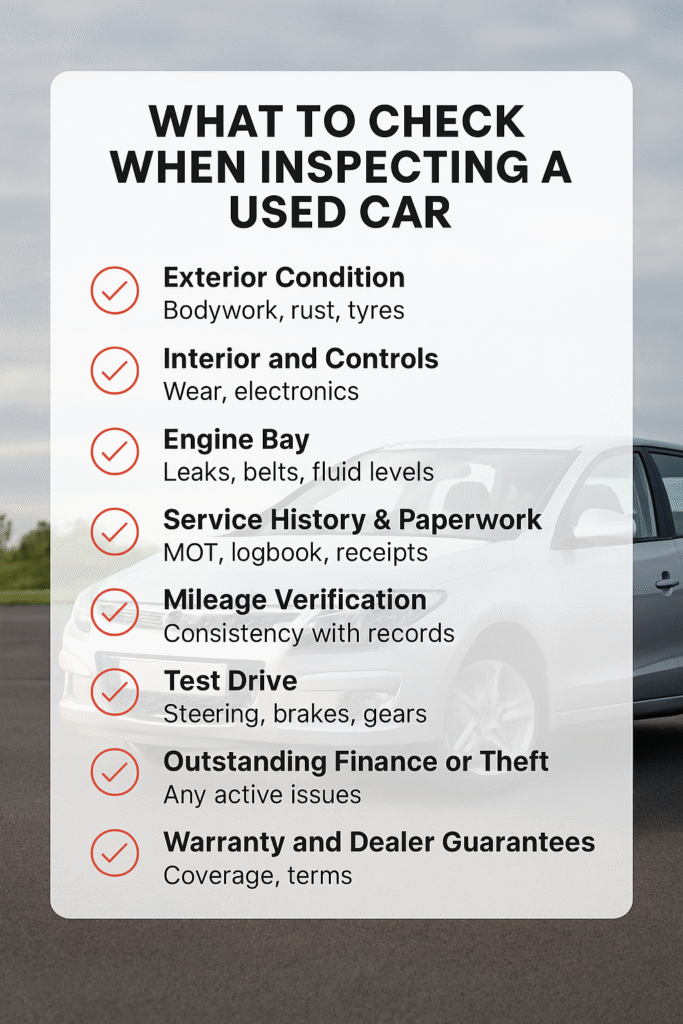
Planning to buy a used car in the UK? Learn what to look for when inspecting a vehicle, from bodywork and engine condition to paperwork and service history.
What You Need to Know When Inspecting a Used Car Before Buying in the UK
Buying a used car in the UK can save you thousands compared to a brand-new model — but it also comes with a few risks if you’re not careful. Whether you’re buying from a dealership or a private seller, knowing what to inspect can help you avoid costly mistakes and ensure you drive away with confidence.
Here’s your complete guide to inspecting a used car before you buy.
1. Exterior Condition
Start with a full walkaround of the vehicle. Look for any signs of accident damage, poor repair work, rust, dents, or mismatched paint. Check that all panels line up evenly and that doors, boot, and bonnet open and close smoothly. Examine the tyres for tread depth and even wear — uneven tread might point to alignment or suspension issues.
2. Interior and Controls
Check the interior for general wear and tear. Worn-out pedals or sagging seats may indicate higher mileage than advertised. Test all electronics: windows, wipers, indicators, heating, air con, infotainment system, and dashboard lights. Make sure no warning lights remain on when the engine is running.
3. Engine Bay
Pop the bonnet and inspect the engine area. While you don’t need to be a mechanic, look for signs of oil leaks, worn belts, cracked hoses, or low fluid levels. A clean engine isn’t everything — but major oil stains or corrosion are red flags.
4. Service History & Paperwork
Always check the service book, MOT history, V5C (logbook), and receipts for past work. You’ll want proof of regular servicing and any major repairs. Make sure the VIN on the chassis matches the logbook. You can check MOT history for free at gov.uk/check-mot-history.
5. Mileage Verification
Confirm that the mileage on the dashboard matches the last recorded MOT or service record. Unusual gaps in history or very low mileage for an old car might suggest mileage tampering.
6. Test Drive
Always test drive the vehicle. Pay attention to how it starts, how the steering feels, how the brakes respond, and how smoothly it shifts gear. Listen for strange noises from the engine, wheels, or suspension. Try to test it on a mix of roads if possible — urban and motorway.
7. Check for Outstanding Finance or Theft
If buying from a private seller, consider running a vehicle history check (e.g. via HPI Check or AutoTrader). This reveals if the car has outstanding finance, has been written off, or is listed as stolen.
8. Warranty and Dealer Guarantees
If you’re buying from a dealership like LIABLE CARS. SCO LTD, check what warranty is included. All our vehicles come with a 1-year warranty as standard, giving you added peace of mind. Private sellers are not legally required to offer any warranty — so inspect more carefully in those cases.
Final Thoughts
Inspecting a used car isn’t just about kicking the tyres — it’s about understanding the vehicle’s condition, history, and value. If you’re not confident doing it yourself, consider bringing a mechanic or using a pre-purchase inspection service.
At LIABLE CARS. SCO LTD, every vehicle is fully inspected, serviced, and delivered with verified documentation and warranty — so you can buy with confidence, wherever you are in the UK.


Leave a Reply